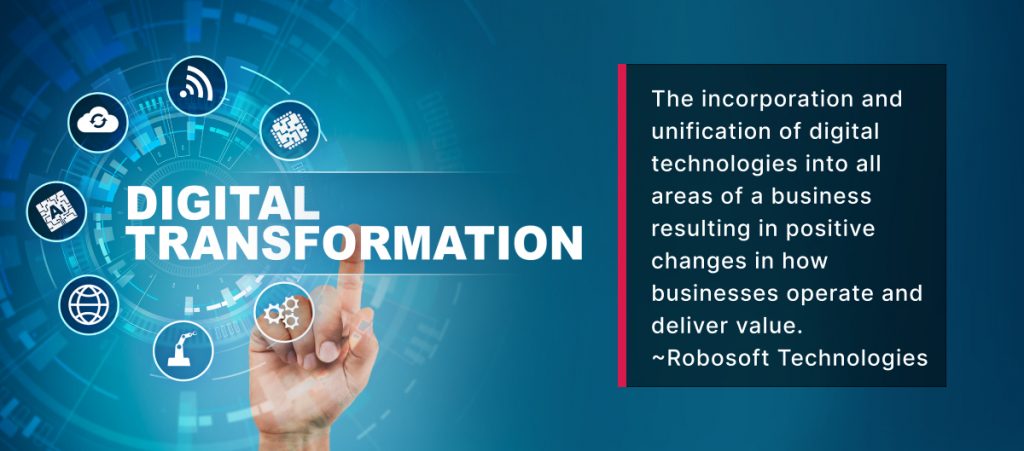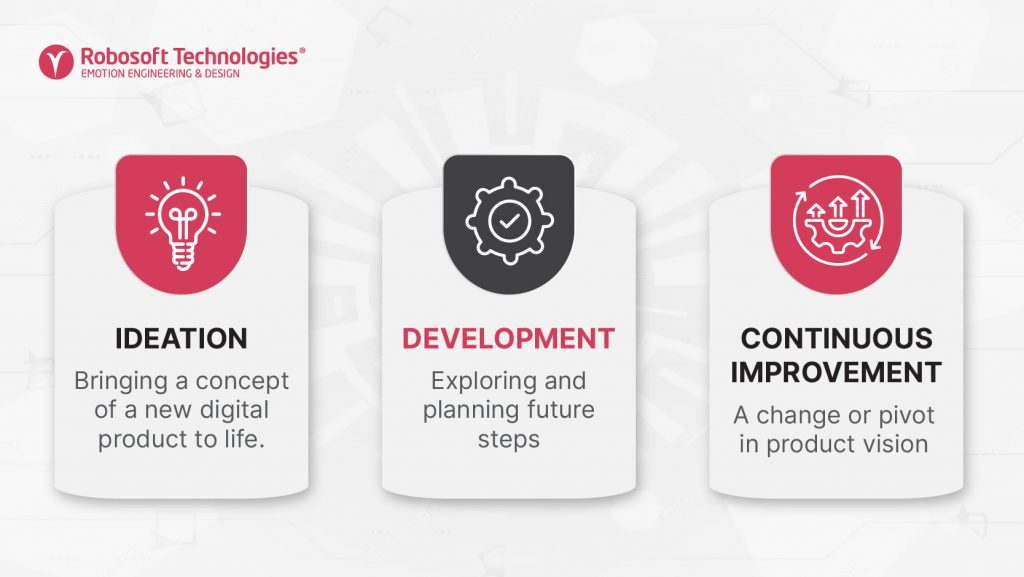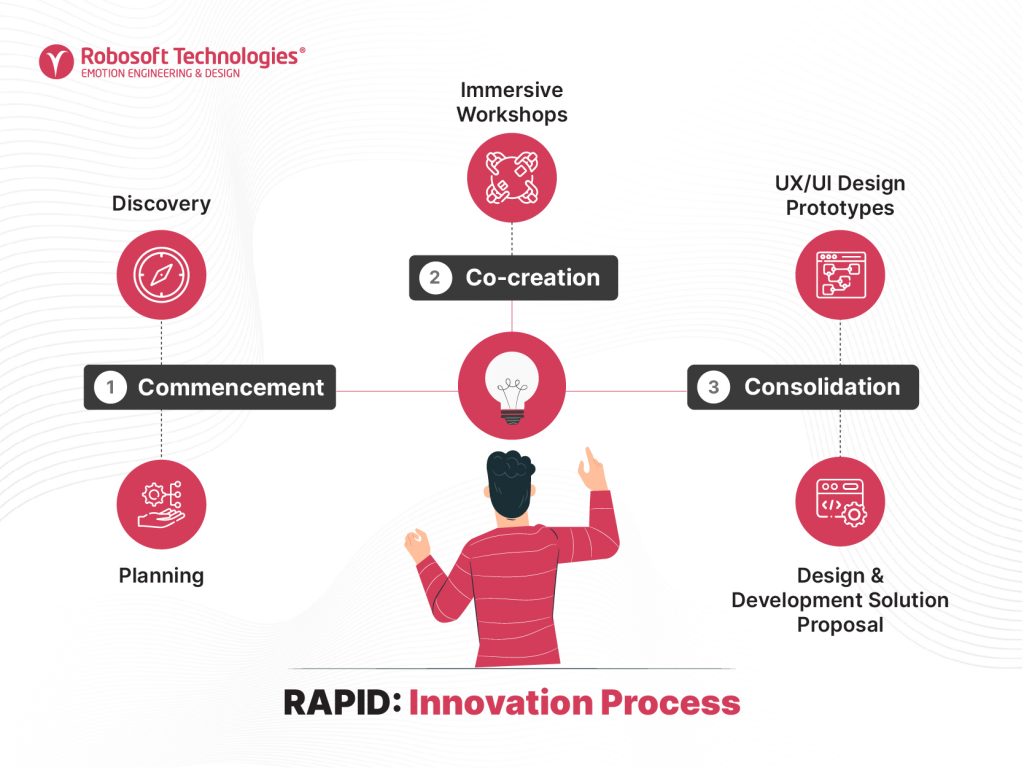In today’s fast-paced world, innovation isn’t just a business goal; it’s a necessity. Producing new products, improving existing ones, and creating solutions for future needs make Digital Transformation a requirement in every industry.
What is Digital Transformation?
At Robosoft Technologies, we define digital transformation as “the incorporation and unification of digital technologies into all areas of a business resulting in positive changes in how businesses operate and deliver value.”
We know, we know. That’s a mouthful. But, more importantly, it’s an informative reminder that our current consumer culture demands that businesses constantly challenge the status quo. As Howard King, head of data and analytics at Rufus Leonard, wrote in an article for The Guardian, “Businesses don’t transform by choice. Why would they want that? It is expensive and risky! They transform because they have no alternative.”

Because we understand the necessities and risks surrounding Digital Transformation, we work with our clients to implement change based on the principles of a holistic problem-solving framework — Design Thinking.
What is Design Thinking?
Design Thinking is a creative but practical method for problem-solving that has evolved from fields as varied as engineering, architecture, and business. It helps companies understand the hidden loopholes, not to mention the potholes they have to confront when finding the best answer to a problem. Design Thinking can also measure a project’s success or lack thereof. Within the Design Thinking framework, Robosoft and our clients can challenge the scope of our thought processes and ability to push their boundaries. That’s why Design Thinking is the foundation of our Digital Transformation strategies.
Three significant elements of Design Thinking: Empathy, Iterativeness, and Collaboration.
Although there are several renditions of Design Thinking, we’ve found that Empathy, Iterativeness, and Collaboration seem common to all. Many companies, realizing how important design advances are to profitability, are beginning to invest in Design Thinking initiatives. So, we are now offering our clients a cutting-edge innovation focused on creating new digital products. It’s called RAPID – an acronym for Robosoft Accelerator for Product Innovation in Digital.
Here’s How an Accelerator for Digital Product Innovation Helps Business
Virtually every product category is witnessing a constant and continuous need to keep up with business, technology, and user trends. If that weren’t challenging enough, new features and products could be copied or improved upon by the competition. So, speed is of the essence, along with user-centricity. And the Robosoft Accelerator for Product Innovation in Digital (RAPID) fills this need.
RAPID can accelerate innovation in all three stages of a product’s life cycle: Ideation, Development, and Continuous Improvement.

How RAPID Works in Just Eight Weeks
1. Commencement Phase-
In the Commencement Phase, we lay down the groundwork for the project. This covers initial planning and a discovery process with select business stakeholders that includes:
- agreeing on the product’s intent and vision.
- conducting empathy-based user research
- defining key challenges and pain points
- conducting a competitive analysis and benchmarking
2. Co-creation Phase-
In the Co-creation Phase, the longest part of the process, immersive workshops are held for key business stakeholders, and team members agree to follow a common goal. Together, the team validates requirement features and scope.
3. Consolidation Phase-
In the Consolidation Phase, the team considers UX/UI Design Prototypes. Bringing all of the project’s elements together, they refine them and create a final proposal for the project’s design and development.

Five More Reasons RAPID Makes Business Sense
- It Reduces Risk: Through iterative testing and prototyping, RAPID helps to reduce the risk of investing resources in products or services that may not meet customer needs.
- It Increases Efficiency: Using an iterative Design Thinking process; organizations can identify and address potential issues early on, reducing the need for costly revisions later.
- It Ensures Stakeholder Engagement and Buy-in: By involving stakeholders in the Design Thinking process, companies can better see the complete product development process. It helps all stakeholders to stay on the same page.
- It Enhances Customer Satisfaction: Design Thinking puts the customer at the center of the process, ensuring their needs and preferences are understood and met. This leads to more satisfied customers and higher customer loyalty.
- It offers a Competitive Advantage: Creative problem-solving helps organizations identify new and innovative solutions. When combined with an understanding of user expectations, creative problem-solving provides a competitive advantage to companies by delivering more relevant and compelling products and services.
Strategizing with Design Thinking Greatly Improves Corporate Performance
According to Fortune, businesses incorporating Design Thinking into their corporate strategy may outperform industry rivals by as much as 228%. But to continue this success, cognitive science and user experience expert Don Norman suggests that companies must evolve away from designs that center only on single users to those that focus on solving the community’s needs. Ultimately, this human-centered design will lead to corporate goals that solve global problems while satisfying individuals. And, in this fast-paced digital world, RAPID can lead the way in creating more satisfied customers and profitable companies.





